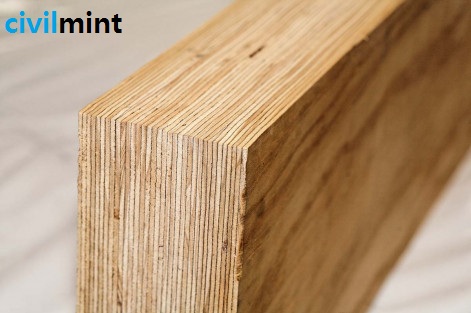Laminated veneer lumber is a high-strength engineered wood formed by bonding multiple layers of thin veneers layer by layer using an adhesive. is designed to take advantage of new species and small trees not available for hardwood production.

Laminated veneer lumber is an economical and sustainable building material that provides high structural strength and reliability when used in building structures.
This article describes the functions, properties, and applications of laminated veneer lumber in the construction industry.
Table of Contents
Characteristics of Laminated Veneer Lumber
- Laminated veneer lumber belongs to the Structural Composite lumber category and is made from dried, graded wood veneers, strands, or shavings.
- The veneers are layered on top of each other and bonded with a moisture-resistant adhesive. The veneer is laid in one direction. That is, the wood fibers are perpendicular to the length of the workpiece.
- The veneers used to make laminated veneer lumber are less than 3 millimeters thick and are produced by rotary peeling. These veneers are well processed, scanned for defects, analyzed for moisture, and cut to 1.4 meters wide with a rotary clipper to produce laminated veneer lumber.
- Laminated veneer lumber is prone to decay when exposed to high humidity or used in poorly ventilated areas. Therefore, laminated veneer lumber must be treated with a preservative to protect against spoilage or infection for these applications.
- Laminated veneer lumber can be sawed, nailed, and drilled with common tools. Holes can also be made in these elements for service installation.
- Laminated veneer lumber sheets or blanks are manufactured in thicknesses of 35 to 63 mm and lengths up to 12 meters.
- The fire resistance of laminated veneer lumber is similar to that of solid wood with a slow and predictable rate of carbonization. The proportions depend on the type of wood used and the size of the elements.
- Because laminated veneer lumber veneers are oriented in one direction, they are particularly suitable for beam fabrication. The length, depth, and strength of laminated veneer lumber beams can effectively withstand loads over large spans.
Advantages of Laminated Veneer Lumber
- Laminated veneer lumber has a good size/strength and weight/strength ratio.
- Small Laminated veneer lumbers have greater strength than solid wood.
- It is also strong for its weight.
- It is the most durable wood material in terms of density.
- Laminated veneer lumber is a versatile wood-based product.
- Available with plywood, wood, or oriented strand board (OSB). Depending on the manufacturer, Laminated veneer lumber can be produced in almost any size and size sheet or blank.
- Laminated veneer lumber is made of wood material with uniform quality and minimal defects.
- Therefore, the mechanical properties can be predicted easily.
Disadvantages of Laminated Veneer Lumber
Laminated veneer lumber requires proper handling and storage requirements to avoid warping issues. Despite the low production cost, laminated veneer lumber requires a large initial capital investment.
Uses of Laminated Veneer Lumber
Laminated veneer lumber can be used to make I-beams, beams, columns, lintels, road signs, lintels, corner boards, formwork, slabs, and more. The high tensile strength of laminated veneer lumber compared to solid wood is a common choice for trusses, purlins, and roof trusses. , pitched rafters, etc.
Laminated veneer lumber requires proper handling and storage requirements to avoid warping issues. Laminated veneer lumber requires a lot of initial capital investment even if the production cost is low.
